Why Content Marketing? The simple answer is because high-value content and multiple distribution tactics deliver results.
No wonder 91 percent of B2B marketers are doing content marketing. According to Content Marketing Institute’s recent 2013 B2B Content Marketing Research Report, B2B marketers are increasing their budget for content marketing and are using more tactics. Highlights of the research are:
- B2B marketers are spending 33 percent of their marketing budgets on content marketing, and the majority plan to increase their content marketing spending in the next 12 months.
- Content marketers are using more tactics. On average, they use 12 tactics. Top distribution tactics include social media, articles on your website, e-newsletters, blogs, case studies, white papers, webinars, infographics, and branded content tools.
- Distribution with social media has increased. 87 percent of marketers are using social media to distribute content, LinkedIn surpassing Twitter as the most popular channel.

We, at Technology Multipliers, believe that content marketing strategy should be your top marketing priority for technology products which typically have long sales cycles. From awareness and interest, to evaluation and decision making phases, content marketing is the most cost-effective way to generate qualified leads, engage, inform, persuade, and pull your prospects through the sales funnel to the buying decision.
Balanced content coverage for each phase in the buying cycle is necessary from initial awareness to decision. However, since technology buyers spend almost half of the sales cycle in the so-called “consideration” or “evaluation” phase, it is important to build your content marketing program around this phase. According to CEB Marketing and Communications, on average, customers will contact a sales rep when they independently completed about 60% of the purchasing decision process.
Key Considerations for Your Content Marketing Program
1. Audience, Engagement, Action – You can not engage your target audience without relevant content. But, relevance is not sufficient. Once engaged, the content needs to be authentic. It needs to create a personal and emotional connection with your audience. Some of the most effective content marketing examples involve stories and humor. Of course, the end goal is for your audience to take some action as a result of engaging with the content.
2. Vocabulary – One of the most critical aspects of your content marketing program is the vocabulary. Start with a complete list of concepts, keywords, and named entities such as product names, codes, or model numbers. Then, define synonyms and related concepts. Finally, organize the vocabulary in a taxonomy. This taxonomy is not only useful for tagging the content on your website but also for search engine optimization and social media (read LinkedIn company profile and Twitter hashtags).
2. Visuals – Another key consideration is the use of visuals and multimedia. Start building a library of graphics, images, photos, and videos. Then, use your vocabulary to tag them. Finally, list how you can use each piece of visual or multimedia with each content marketing tactic. For example, how can you use the same visual in your blog, white paper, and webinar presentation?
3. References and Links – Creating original, high-value content takes time. Especially creating relevant content for technology buyers requires thorough research, checking references (internal and external), ensuring proper credits given to the sources of information, and linking to related information.
4. Traceability and Measurement – Content creation, publishing, and distribution are important. So are traceability and measurement. Traceability of content usage by each unique user can help in many ways. Knowing how many different content types were consumed, the date, time, and frequency of consumption, may be invaluable information in the sales process. This information helps assess where your website visitor is in the buying cycle. Knowing how many people from the same account consumed your content helps confirm the stage of that opportunity. Thanks to Marketing Automation Systems (MAS) and integration with CRM systems, traceability and measurement are much easier now than ever.
5. Fine tuning and Re-purposing – A side benefit of tracing the usage is the ability to fine tune your content or re-purpose based on implicit and explicit feedback. Implicit feedback can come from MAS and web analytics tools. Explicit feedback can come from a response to a simple question such as “Was this useful?” Unique actions and interactions of users with content may provide valuable clues to improve the content as well as the content marketing program. These clues and ability to fine tune can make a huge impact in closing sales for technology products with long sales cycles.
6. Alignment with Social Media and Search Marketing – According to Lee Odden, the author of TopRank blog, successful content marketing programs should almost always be synched up with social media programs that lead to sharing and conversations and search-based marketing programs that generate traffic, leads, and conversions. We agree.
Want to learn more about content marketing and integrated online marketing for technology companies? Download our eBook about Internet Marketing.
